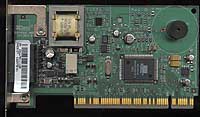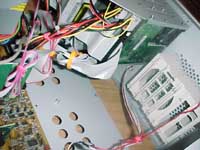Future Power - Power Series P3-500
by Anand Lal Shimpi on October 3, 1999 12:13 AM EST- Posted in
- Systems
Modem & Multimedia Keyboard
The Power Series system features a software (aka winmodem) 3com/USR 56K modem. The performance on the modem is average for a 56K. With connection trends moving towards Cable modems and xDSL lines, it is disappointing to see the lack of an Ethernet card present in the system, even an optional Ethernet card would be desired.
The system ships with a standard Microsoft Intellimouse (aka the "wheelymouse") as well as the Future Power 911C Multimedia Keyboard. The 911C features the standard 104 key layout, with each key boasting good tactile feel and it is fairly comfortable to type on for a standard keyboard. In addition to the regular 104 key layout, there are 16 extra buttons that control various options under Windows 98. The buttons are programmable and are controlled by a utility under Windows 98 (no NT support). By default, there are buttons for shutdown, suspend, help, as well as buttons to launch your default web browser and other applications. DVD/audio CD playback can also be controlled via the keyboard as it features your standard 5 playback functions as well as volume up/down and mute buttons.

Case & Cooling
The case used by Future Power for the Power Series is the Inwin A500 with a custom made front panel. The case itself is quite well made, with mostly smoothed edges but a couple that are a tad on the sharp side. The 250W power supply is mounted vertically, which unfortunately prevents the CPU from being accessed via the power supply. However, the case features a removable motherboard tray, so the power supply does not have to be removed in order to access the CPU.
The power supply is very quiet, as is the fan on the CPU. The loudest device in the system seems to be the hard drive, which isn't bad at all. All of the cables are tied up in order to promote a path of cooling air through the case, but with the only fan, other than the CPU fan, being the power supply fan, a great deal of the air in the case remains stagnant. Luckily, the option of installing a secondary case fan at the front of the case is possible but, its too bad that Future Power chose not to take this option for us.
The case features a total of 6 drive bays, three external 5.25" bays, two of which are occupied by the DVD player and the NEWQ Gold, two external 3.5" bays, both of which are occupied by the floppy and Zip drives, and an internal 3.5" bay which is occupied by the Western Digital hard drive. This leaves only a single 5.25" drive bay left for expansion, and if you add a CD-RW, you will be left with nothing, so be sure to consider expansion in your decision, as this configuration doesn't allow for much of it.
Overclocking
Without modifying the case or the cooling setup in any way, using the 115MHz FSB setting on the BH6, we were able to clock the Pentium III 500 up to 575MHz at the default 2.0v core voltage without sacrificing any noticeable stability. However, to keep things running smoothly, we bumped the core voltage up to 2.05v, just to be safe, after we experienced a few crashes down the line.
As we discussed before, the Diamond Stealth III S540 can be pushed to beyond the 125/125MHz (core/mem) default clock of the card, with 143/143MHz being the sweet spot for the card. The performance improvement going from 125/125 to 143/143 offers is decent but, it does not make up for the fact that the Savage4 still isn't the ideal gaming card.
The Micron SDRAM had no problem handling the 115MHz FSB setting, and the system gave us an overall performance increase of 7% as a result of the 75MHz overclock. It isn't much, but it isn't bad considering that it didn't cost us a penny to do it - ah the joys of overclocking. With a bit of added cooling, hitting above 575MHz shouldn't be that big of an ordeal, but we're not dealing with the number of ways you can overclock this Pentium III 500 here, rather, we're just identifying the potential for overclocking with the system. You didn’t think Future Power used the ABIT BH6, one of the most overclockable boards of its time, for nothing now did you?












0 Comments
View All Comments